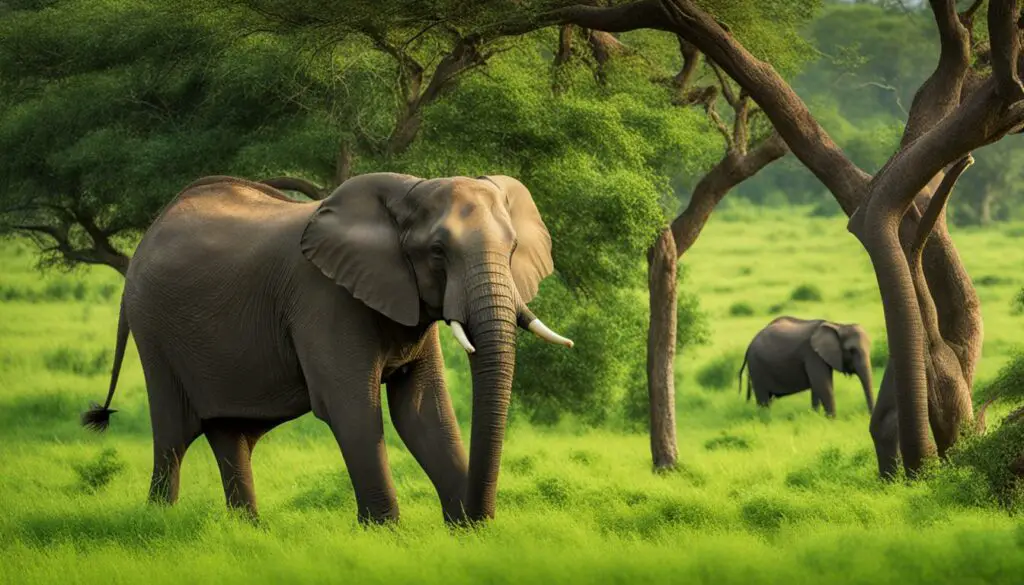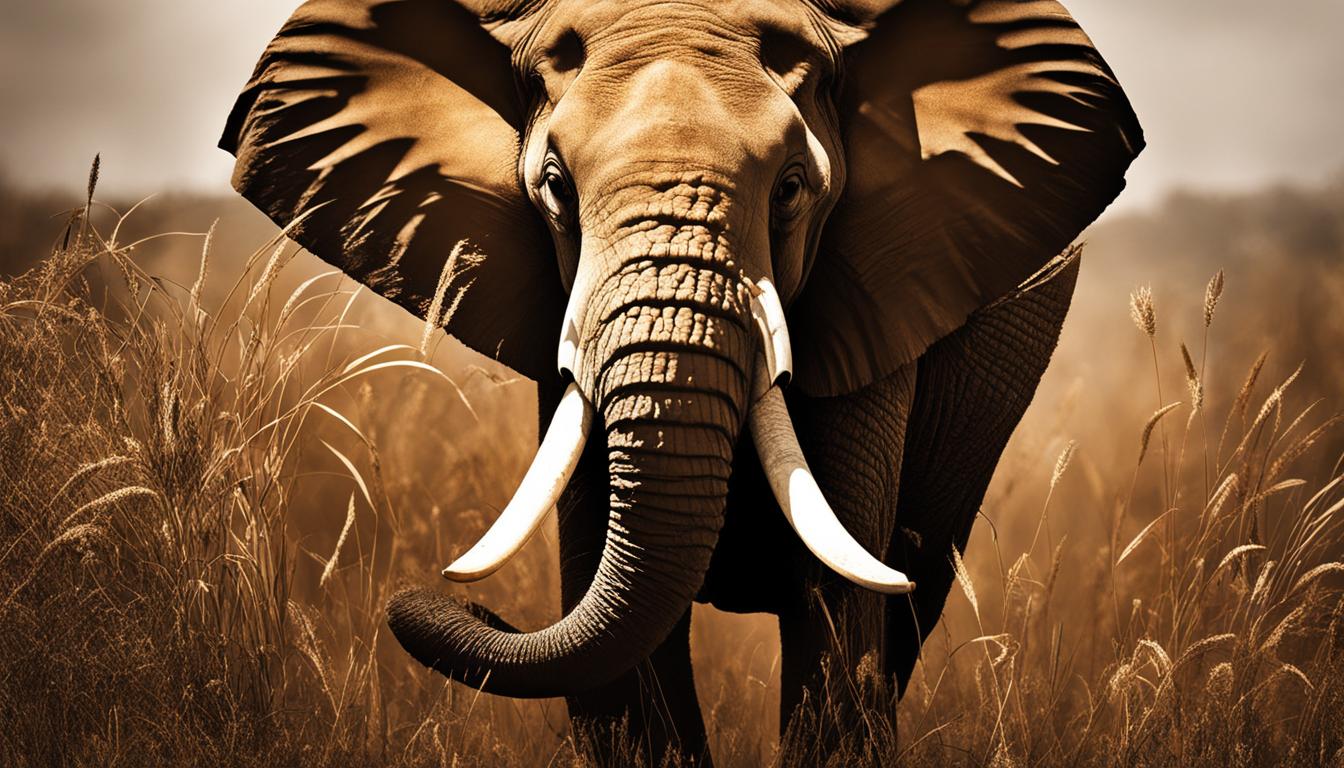Welcome to our article on the fascinating world of elephants and their dietary habits. In this section, we will explore the elephant diet, what elephants eat, and how they feed.
Did you know that elephants consume an astonishing amount of vegetation daily? They can devour between 149 and 169 kg (330-375 lb.) of food each day! Their menu includes a wide variety of plant-based delights, such as grasses, small plants, bushes, fruit, twigs, tree bark, and roots.
To aid digestion, elephants love to munch on tree bark. It provides not only nourishment but also helps with their digestive process. And when it comes to hydration, adult male elephants can gulp down a whopping 212 liters (55 gallons) of water in just under five minutes!
But that’s not all—in their quest for essential minerals and salt, elephants will even use their powerful tusks to dig up the earth. By churning the ground, they access vital nutrients that contribute to their overall well-being.
Join us as we delve deeper into the extensive diet of elephants, their feeding habits, and the importance of their dietary needs for their survival.
The Extensive Diet of Elephants
Elephants have a diverse diet, consuming a variety of vegetation to meet their nutritional needs. They are herbivorous animals and strictly vegetarian, relying on plants as their primary source of food. Elephants eat leaves, shoots, roots, tree bark, fruits, twigs, bushes, and shrubs. Whether it’s grasses, small plants, or tree bark, there is no shortage of options for these gentle giants.
Interestingly, Asian and African elephants have slightly different dietary preferences. Asian elephants are known to prefer monocot plants such as palms, bamboo, and grasses. On the other hand, African elephants tend to consume foliage from tree saplings. This distinction in food preference showcases the adaptability of elephants in different habitats.
In addition to their diverse plant-based diet, elephants also require a significant amount of water. They can drink about 100-200 liters (25-50 gallons) of water per day to stay hydrated. Water is essential for digestion and overall bodily functions.
| Elephant Diet | Asian Elephants | African Elephants |
|---|---|---|
| Preferred Plants | Palms, bamboo, grasses | Foliage from tree saplings |
| Water Consumption | About 100-200 liters (25-50 gallons) per day | About 100-200 liters (25-50 gallons) per day |
The extensive diet of elephants ensures they obtain the necessary nutrients for their survival. Their ability to consume a wide range of vegetation showcases their adaptability in various ecosystems. The preservation of their habitats and the availability of adequate food sources are crucial in maintaining the health and well-being of these magnificent creatures.
The Feeding Time and Habits of Elephants
Elephants spend a significant amount of their day feeding, dedicating approximately 16-18 hours to this essential activity. Feeding accounts for nearly 80% of their daily routine, highlighting the importance of sustenance for these magnificent creatures.
Elephants exhibit both grazing and browsing habits, depending on their habitat and food availability. Grazing involves consuming grass and vegetation close to the ground, while browsing entails feeding on leaves, twigs, bark, and other plant parts. This diverse feeding behavior allows elephants to obtain the necessary nutrients for their survival.
As herbivorous animals, elephants require a substantial quantity of food to sustain their massive size and energy needs. Their feeding time is extended due to the need to consume a large amount of food. The extensive feeding habits of elephants reflect their dietary requirements and the effort required to meet them.
Grazing and Browsing: A Balance of Diets
Elephants’ ability to both graze and browse contributes to their ecological impact and dietary needs. Grazing provides elephants with grasses that are rich in nutrients, while browsing offers a more varied diet that includes leaves, bark, and other plant parts. This balance of diets helps ensure that elephants receive a diverse array of essential nutrients.
| Grazing | Browsing |
|---|---|
| Grasses | Leaves |
| Vegetation close to the ground | Twigs |
| Bark |
Grazing and browsing behaviors are influenced by various factors, such as habitat type and availability of food sources. The adaptability of elephants in their feeding habits enables them to survive in diverse environments and make use of a wide range of vegetation.
Understanding the feeding time and habits of elephants is crucial in appreciating their unique dietary needs and ecological roles. By preserving their habitats and ensuring their access to suitable food sources, we can contribute to the conservation and well-being of these remarkable creatures.
The Importance of Diet for Elephant Survival
When it comes to the survival and well-being of elephants, their diet plays a crucial role. Elephants are herbivorous animals and have specific nutritional needs that must be met to sustain their massive size and energy requirements. Their diet provides the necessary nutrients for their daily activities, such as long-distance walking and maintaining body temperature.
These gentle giants consume a large quantity of food to compensate for their poor digestion, as only about 44% of the food they ingest is digested. This means that elephants spend a substantial amount of their day feeding to ensure they obtain enough nutrients. In fact, elephants spend approximately 16-18 hours per day feeding, which accounts for nearly 80% of their day.
The elephant’s diet consists of a diverse range of vegetation, including grasses, leaves, bark, fruits, and even tree saplings. They are both grazers and browsers, depending on their habitat and food availability. Grazing involves eating grass and vegetation close to the ground, while browsing involves consuming leaves, twigs, and bark from trees and other plants.
| Nutritional Benefits | Quantity Consumed |
|---|---|
| Grasses and vegetation | Large quantities |
| Leaves, twigs, and bark | Diverse range |
| Fruits | Occasional treats |
In addition to their daily food intake, elephants also require a significant amount of water. Adult male elephants, for example, can drink up to 212 liters (55 gallons) in less than five minutes. Water is crucial for elephants to maintain hydration and support their digestion process.
Understanding the importance of diet for elephant survival is essential in ensuring the well-being of these magnificent creatures. Preserving their habitats and ensuring access to adequate food sources are crucial steps in promoting the survival of elephants in the wild. By protecting their natural environment and providing them with the nutrition they need, we can contribute to the conservation efforts for these incredible animals.

Feeding Challenges for Elephants
Elephants face several feeding challenges, particularly in regions where human activity and habitat loss have affected their food sources. As human populations expand, elephants often encounter obstacles such as habitat fragmentation and limited access to natural resources. These challenges can have a detrimental impact on their ability to find appropriate food.
In times of drought, elephants may need to travel long distances in search of sufficient food and water. These journeys can be physically demanding and increase the risk of exhaustion and dehydration. Elephants rely on a diverse diet of vegetation to meet their nutritional needs, but when their usual food sources become scarce or inaccessible, it puts their survival at risk.
“The preservation of elephant habitats and ensuring their access to adequate food sources are essential for their survival.”
- Loss of habitat: Human encroachment and deforestation have resulted in the loss of elephant habitats, reducing the availability of food.
- Competition with livestock: In some areas, elephants must compete with livestock for grazing areas, further limiting their access to food.
- Human-wildlife conflict: Elephants raid crops in search of food, leading to conflicts with local communities and retaliatory measures that can further disrupt their feeding patterns.
Addressing these feeding challenges requires a multi-faceted approach that focuses on conservation efforts, sustainable land management practices, and creating buffer zones to protect elephant habitats. By safeguarding their food sources and ensuring their access to adequate nutrition, we can help secure the survival of these magnificent creatures.
| Feeding Challenges | Impact |
|---|---|
| Habitat Loss | Reduces availability of food |
| Competition with livestock | Limits access to grazing areas |
| Human-wildlife conflict | Disrupts feeding patterns and leads to retaliation |
The Impact of Elephant Diet on the Environment
Elephants, with their extensive diet, play a significant role in shaping their surrounding environment. African elephants, known for their browsing habits, can leave behind barren lands as they consume saplings and shrubs indiscriminately. This grazing behavior can lead to changes in the vegetation composition and structure of their habitats. Researchers have studied the impact of elephants on their environments to better understand the ecological consequences.
On the other hand, Asian elephants have been observed as “daintier eaters,” focusing more on clearing palms and grass. Due to their selective grazing habits, Asian elephants cause fewer scars on trees and have a less destructive impact on their habitats. They primarily consume monocot plants like bamboo and grasses, which allows for the regeneration of the vegetation in their surroundings.
The contrasting grazing habits of African and Asian elephants highlight the need for sustainable conservation practices. Balancing the elephant population and their access to diverse and adequate food sources is crucial for maintaining the ecological balance of their habitats. It requires careful planning and management to ensure the preservation of both elephant populations and the surrounding environment.
| Grazing Habits | Impact on Environment |
|---|---|
| African Elephants | Can cause deforestation and leave behind barren lands |
| Asian Elephants | Have a less destructive impact and promote vegetation regeneration |
Conclusion
Understanding the diet of elephants is crucial in comprehending their unique feeding habits and nutritional needs. Elephants are herbivorous animals, consuming a variety of vegetation that includes grasses, leaves, bark, and fruits.
They require a large quantity of food and water to sustain their massive size and daily activities. Preserving their habitats and ensuring their access to adequate food sources are essential in promoting the survival of these gentle giants.
By studying the extensive diet of elephants, we gain insights into their dietary preferences and the challenges they face in finding appropriate food. Human activities and habitat loss have impacted their food sources, making it imperative to address these issues to ensure their well-being.
As we continue to learn more about the impact of elephant diets on their surrounding environment, it becomes increasingly important to implement sustainable conservation practices. By doing so, we can help protect these magnificent creatures and the delicate ecosystems they inhabit.
Does the availability of food influence the seasonal movements of elephants during migration?
The availability of food significantly impacts elephant migratory patterns analyzed. During migration, elephants strategically move in search of areas with abundant food resources. As seasons change and greenery diminishes, they grapple with traversing long distances to find suitable grazing grounds. Understanding this food-driven movement is crucial for conservation efforts and to ensure sustainable migration routes for these majestic creatures.
FAQ
What do elephants typically eat?
Elephants consume a variety of vegetation, including grasses, small plants, bushes, fruit, twigs, tree bark, and roots.
How much vegetation do elephants eat in a day?
Elephants eat between 149 and 169 kg (330-375 lb.) of vegetation daily.
What is a favorite food source for elephants?
Tree bark is a favorite food source for elephants as it aids digestion.
How much water do elephants drink?
Adult male elephants are capable of drinking up to 212 L (55 gal.) in less than five minutes.
Do elephants require salt and minerals?
Yes, elephants will dig up earth to obtain salt and minerals, using their tusks to churn the ground and obtain nutrients.
Are elephants strictly vegetarian?
Yes, elephants are herbivorous animals and strictly vegetarian.
What do Asian elephants prefer to eat?
Asian elephants prefer monocot plants like palms, bamboo, and grasses.
What type of foliage do African elephants consume?
African elephants tend to consume foliage from tree saplings.
How many hours do elephants spend feeding?
Elephants spend approximately 16-18 hours per day feeding, which accounts for nearly 80% of their day.
What is the difference between grazing and browsing?
Grazing involves eating grass and vegetation close to the ground, while browsing involves consuming leaves, twigs, bark, and other parts of plants.
Why do elephants need a large quantity of food?
Elephants require a large quantity of food to sustain their massive size and energy needs.
How much of the consumed food is digested by elephants?
Only about 44% of the food is digested by elephants due to their poor digestion.
What challenges do elephants face in finding food?
Elephants can struggle to find appropriate food, especially in regions where habitat loss and human activity have impacted their food sources.
How do elephants impact their surrounding environment?
African elephants, with their preference for saplings, can be quite destructive, leaving barren lands behind.
What is the importance of understanding elephant diet?
Understanding the diet of elephants is crucial in comprehending their unique feeding habits and nutritional needs.











